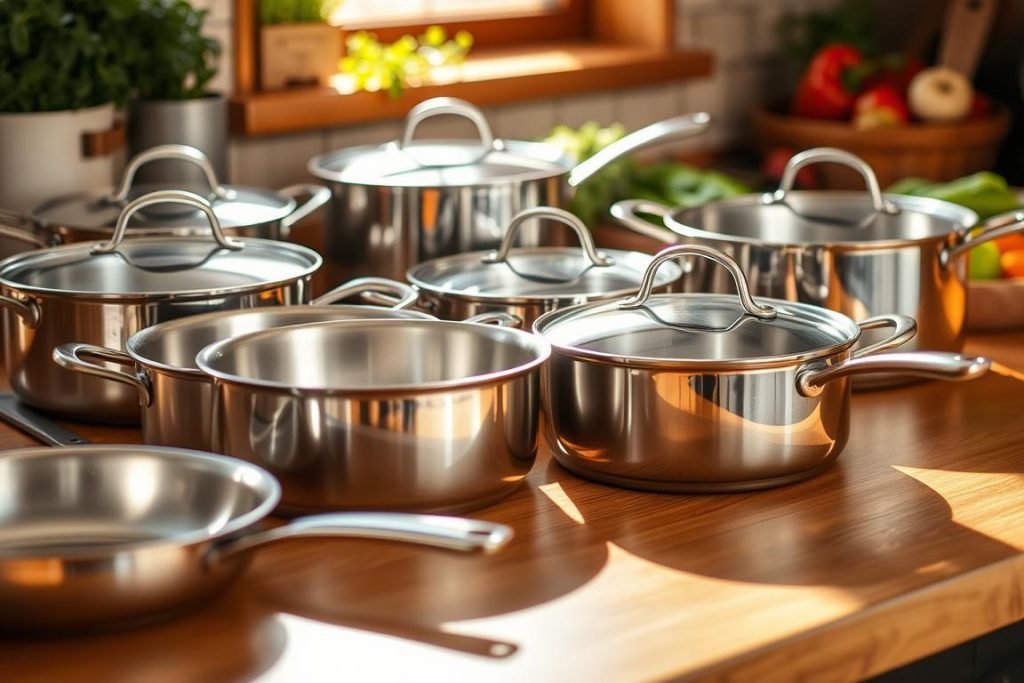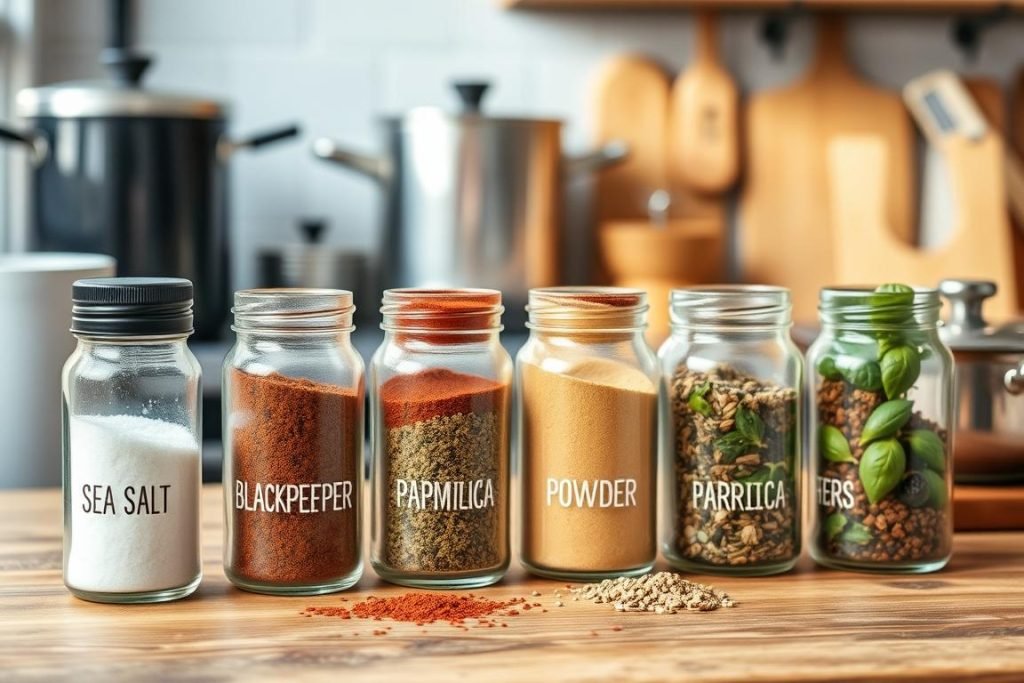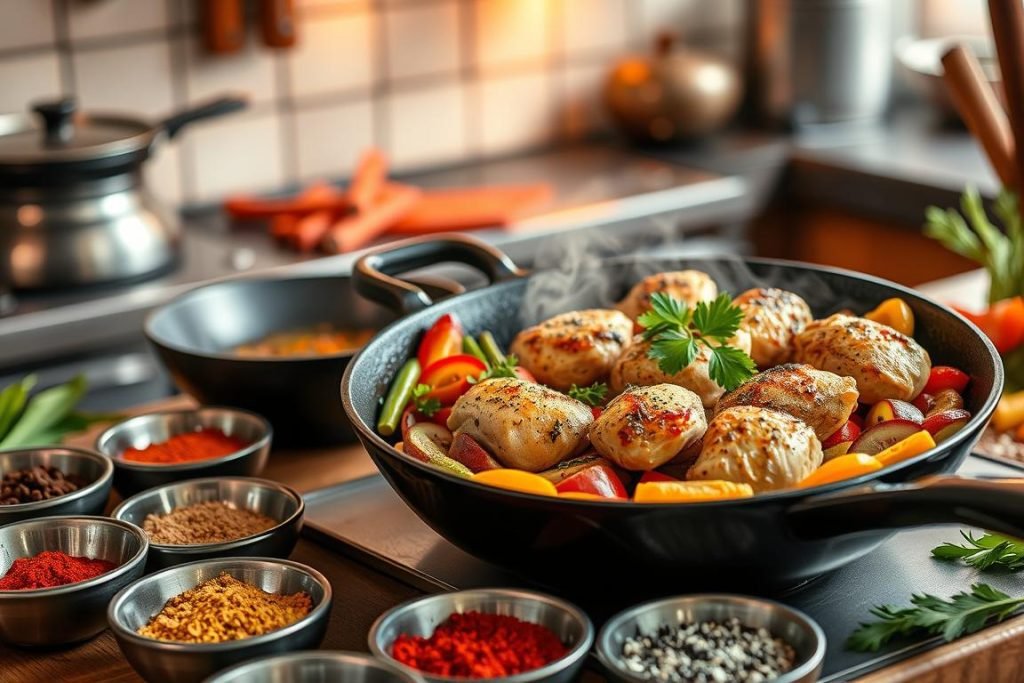Pan Frying Perfection: A Beginner’s Guide

Could knowing one cooking method open a world of food magic? Learn how basic pan frying skills can take a steak from raw to wow. Just a pan and some heat can do wonders. The art of perfect pan frying makes meals delicious. It also teaches you skills you can use in all your cooking.
Grilling was all the rage before, but now people are getting back to stovetop cooking. This is true especially for those living in tall buildings or in cold places. A pan-fried steak is simple but can taste as good as grilled ones. With the right techniques and an eye for when it’s just right, you can make amazing meals at home. This guide will show you the basics for great pan frying every time.
Key Takeaways
- Learning pan frying basics can really boost your cooking skills.
- Knowing how to fry properly is key for the best stovetop steak.
- Stovetop cooking is great when you can’t grill outdoors.
- You can get crispy and juicy food with the right frying way.
- Being ready and paying attention is important for good pan frying.
- This guide teaches skills for cooking more than just steak.
Understanding Pan Frying
Pan frying is a popular way to cook food in a bit of oil. It combines hot oil and the right temperature to make food crispy on the outside and tender inside. We’ll look at what makes pan frying special, including its history and benefits.
What is Pan Frying?
Shallow frying means cooking with a little hot fat on medium-high heat. It’s different from deep frying because it uses less oil. The food doesn’t get totally covered in oil. This method is great for browning food, thanks to the Maillard reaction. This reaction makes food deliciously brown and tasty.
The History of Pan Frying
Pan frying has a long history across the globe. It varies from place to place, using local foods and pans, like tawas in South Asia or skillets in the American South. This cooking style has become a key part of kitchen traditions everywhere.
Benefits of Pan Frying
Pan frying on the stove has many pluses. It makes food tasty, uses oil well, and lets you control the heat closely. This is key for great cooking results. You can cook lots of different foods this way, like meats and veggies. They cook fast without getting too greasy.
| Aspect | Detail |
|---|---|
| Preheated Pan Temperature | 350°F (medium-high heat) |
| Ideal Cooking Oils | Peanut, sunflower seed, sesame, avocado, grapeseed |
| Oil Depth for Cooking | Approximately halfway up the side of the food |
| Cooking Method | Quick, suitable for thin and lean cuts of meat |
| Common Food Items | Fish filets, chicken cutlets, pork chops, sturdy vegetables |
| Moisture Retention | Creates steam that helps cook food while retaining moisture |
| Healthy Cooking Option | Reduces oil absorption due to steam barrier |
| Searing Option | Can be done with minimal or no oil, especially for marbled meats |
Understanding pan frying shows it’s more than a technique. It’s a global culinary tradition. Pan frying balances taste and nutrition well. It is loved in kitchens all around as a favorite way to fry food on the stovetop.
Essential Equipment for Pan Frying
Getting good at pan frying means having the right tools. Whether it’s searing steaks or making crispy chicken, your equipment matters a lot. This guide will show you the key items you need. It covers from frying pans to must-have gadgets.
Choosing the Right Frying Pan
Choosing the right pan is key for great pan frying. Cast iron skillets and stainless steel pans are top picks. They handle high heat and cook evenly. Using these helps make food taste better by browning it just right.

Cast iron keeps heat really well, perfect for searing meat. But, it needs care like seasoning to stay non-stick. Stainless steel pans are easier to keep up. Yet, they might need more oil or butter.
Must-Have Utensils
Good utensils are as important as a good pan. You’ll need long tongs and spatulas for safe food flipping. For careful flip without breakage, consider the upgrade pick for the fish spatula costs $65 on Amazon. Plus, a solid whisk and ladle are great for sauces or basting.
Temperature Control Tools
Keeping the right temperature is vital in pan frying. A meat thermometer makes sure your food is safely cooked. It helps you hit the safe internal temperatures easily.
| Tool Type | Description | Cost on Amazon |
|---|---|---|
| Plastic Meat Thermometer | Digital, quick read | $24 |
| High-End Meat Thermometer | Analog, leave-in style | $60 |
Right tools can change everything in pan frying. High-quality gear doesn’t just improve cooking. It also ensures safety and durability.
Selecting Ingredients for Pan Frying
Choosing the right ingredients is key in pan frying. It starts with picking the best proteins, veggies, and oils. Picking well helps your dish taste great and have the perfect texture.
Best Types of Proteins
Cuts of beef like ribeye or New York strip are great. They have fat that makes them tasty and moist. Quick-cooking meats such as chicken breasts or pork chops are also good. They cook fast, stay moist, and get a nice golden crust.
Ideal Vegetables for Pan Frying
Cauliflower, Brussels sprouts, and mushrooms work well for pan frying. They don’t fall apart with high heat and get crispy. This makes the dish taste and feel better.
Choosing the Right Fats and Oils
Picking the right cooking oils is crucial. Use high smoke point oils like canola, grapeseed, and avocado. They can handle high heat well. This keeps your food from burning.

To wrap it up, choosing the right meats, veggies, and oils is important. Go for meats with good fat, fast-cooking meats, sturdy veggies, and stable oils. This will make your pan-fried dishes taste amazing.
Preparing Your Ingredients
Getting your ingredients ready is the first step. This makes a simple meal amazing. We’ll look at marinating, cutting, and seasoning to make your food better.
Marinating Tips
Marinating makes your proteins juicy and flavorful. A marinade with vinegar or citrus juice works well. It makes tough parts soft and adds deep flavors.
Cutting Techniques
How you cut ingredients matters a lot. Making cuts the same size cooks them evenly. Cut meat against the grain to keep it tender. Cut veggies based on how long they need to cook.
Seasoning Essentials
Seasoning is very important. Start with kosher salt and black pepper. Kosher salt brings out flavors. Black pepper adds a little heat.
Use about 3/4 to 1 teaspoon of kosher salt for each pound of meat. This helps form a crust and makes the color rich when cooking. Follow this guide for how much to use:
| Ingredient | Kosher Salt per Pound | Freshly Ground Black Pepper per Pound |
|---|---|---|
| Beef | 1 tsp | 1/4 tsp |
| Chicken | 3/4 tsp | 1/4 tsp |
| Pork | 1 tsp | 1/5 tsp |
| Vegetables | 1/2 tsp | 1/5 tsp |

When you marinate well, cut precisely, and season carefully, your food tastes great. These steps make sure your pan frying is a success.
The Pan Frying Process
Learning pan frying is key to that perfect crispy texture. It involves high heat cooking. Knowing about heat and time can make your cooking better.
Preheating Your Pan
Start by making your pan hot until the oil shimmers. Not too hot to smoke a lot. This step starts the Maillard reaction. This reaction makes browned food tasty.
Proper Oil Usage
Pick the right oil for searing process. Use canola, vegetable, or light olive oil for best results. For non-stick pans, heat the oil with the pan. For others, put oil in a hot pan and spread it well. This makes for a good sear.
Cooking Techniques
Add your food when the pan and oil are ready. Don’t put too much food in at once. It could cool the pan down. Cook time varies by food type. Flip chicken or steaks after 4-6 minutes. Turn fish gently after 3-4 minutes.

Watch the oil’s heat to avoid burning. Keep it between 350 to 375 degrees Fahrenheit. The right heat and timing give food a crispy outside and moist inside.
Follow these steps and practice to get good at high heat cooking. This way, whether it’s steak, chicken, or veggies, your dishes will always stand out.
Common Pan Frying Mistakes
Knowing how to pan fry well means your food gets a perfect crispy crust. But, easy mistakes can spoil taste and texture. Let’s look at what not to do, so your dishes are great.
Overcrowding the Pan
Putting too much in the pan at once is a big no-no. It cools down cooking temperatures. This means food steams instead of sears. To get that crispy crust, give your food space.
Using Cold Ingredients
Starting with cold ingredients in a hot pan isn’t good. They can drop the pan’s heat. This makes it hard to get a nice, browned outside.
Not Monitoring Temperature
Not watching the pan’s temperature is a common mistake. Unstable heat makes cooking uneven. A thermometer helps keep the heat just right, between 350°F and 375°F (175°C to 190°C).
By avoiding these errors, you can master pan frying. It’s about using the right moves and knowing how things work together in the pan.

| Cooking Method | Temperature Range | Oil Type |
|---|---|---|
| Deep Frying | 350-375°F (175-190°C) | Peanut, Canola, Vegetable |
| Pan frying/Sautéing | Medium to High Heat | 1-2 tablespoons, Various Oils |
| Double-frying | First Fry Lower, Second Fry Higher | Canola, Vegetable |
Cleaning and Maintaining Your Frying Equipment
Keeping your frying pans in good shape means cleaning them well and storing them right. Whether you’re dealing with non-stick pan care or cast iron maintenance, each type needs its own care. Also, storing your skillets right stops damage and rust.
Cleaning Non-Stick Pans
To clean non-stick pans like ProCoat, you must be gentle to protect the surface. Never use rough cleaners that can scrape the non-stick coating off. A bit of warm soapy water and a soft sponge are usually enough. If you find hard stains, try a gentle scrub with baking soda and water.
Seasoning Cast Iron Skillets
Cast iron skillets are great for cooking but need regular care to keep them non-stick. Clean with warm water and a soft brush after every use. Dry it well. To season, rub it with canola oil and heat it in the oven at 450°F. This makes it non-stick and stops rust. If you see rust, a salt and water scrub before re-seasoning will fix it.

Storage Tips for Frying Pans
Storing your pans right helps them last longer. Keep them in a dry place. You can hang them or stack them with paper towels in between. This stops scratches. For pans that can rust, like cast iron, make sure they’re dry before storing. Season them often. Covering them keeps them clean for the next use.
By following these steps for non-stick pan care, cast iron maintenance, and proper storage, your cookware will stay in great shape. They’ll be ready for any recipe you want to try.
Pan Frying Variations Around the World
Pan frying is a popular cooking method worldwide. It shows unique techniques from Asia, the American South, and Europe. Each area uses local foods and cooking styles to make comforting dishes.
Asian Techniques and Dishes
In Asia, pan frying is an art, especially stir-frying. It uses high heat and fast stirring. This keeps the food’s flavors fresh and fits the need for quick, healthy meals. Stir-fried veggies and Korean fried chicken are perfect examples. They are tasty and fast to make.
Southern Comfort Foods
The Southern US loves pan frying. It’s key for their comfort food, like fried chicken. This chicken has a crispy skin and juicy middle. It shows the area’s history and culture through food. Pan frying gives dishes a comforting and rich taste.
European Flavors and Styles
Europe uses pan frying in a fancy way. They cook with butter and olive oil. This makes dishes like French foie gras or Italian fried zucchini blossoms delicious. The goal is to make the outside crispy and the inside soft. This highlights Europe’s classy cooking style.

Creative Pan Frying Recipes
Pan frying opens up a world of tasty chances. You can make quick recipes for busy nights or gourmet meals for big days. It’s also great for vegetarian frying options, letting you enjoy tasty plant-based dishes.
Quick Weeknight Meals
When you’re short on time, pan frying makes cooking fast. Things like thin pork chops or veggies turn into amazing meals quickly. Use oils like canola or peanut to avoid burning.
Special Occasion Dishes
For special days, pan frying is perfect for making gourmet meals. Think seared steaks or salmon with crispy skin. The secret is in the heat, timing, and spices, making meals celebration-worthy.
Vegetarian and Vegan Options
Pan frying is great for vegetarian and vegan meals too. Foods like tofu, tempeh, and big veggie slices become crunchy and tasty. Using avocado or coconut oil adds more flavor and keeps it plant-based.
Below is a table showing different pan frying techniques and tips for these dishes:
| Ingredient | Oil Type | Preparation | Cooking Time | Serving Suggestion |
|---|---|---|---|---|
| Pork Chops | Butter & Oil Mix | Seasoned with salt, pepper, and a dash of cayenne | 2-3 mins per side | Serve with new potatoes and a sprinkle of salt |
| Tofu Steaks | Coconut Oil | Press and dry, season with soy sauce and garlic | 3-4 mins per side | Accompany with steamed greens and sesame seeds |
| Salmon Fillets | Avocado Oil | Season with dill and lemon zest | 4 mins per side | Pair with a creamy dill sauce and asparagus |

Pan frying is a key skill for many meals. Whether it’s a quick recipe on a busy day, a gourmet meal for a celebration, or vegetarian frying options, it fits all your needs.
Tips for Perfecting Your Pan Frying Skills
Improving your pan frying can make simple meals great. It’s not just about recipes. It’s a journey. You must be patient and willing to try new flavors. This way, you’ll master the perfect balance of heat and time.
Practice Techniques
Practicing different frying techniques is key. For example, using a bamboo skimmer makes frying safer and easier. It is cheap but very helpful for frying like a pro. Also, using the right pot matters a lot. A Dutch oven works well for many fried foods. Keeping the oil not too full prevents spills and keeps cooking safe.
Learning from Mistakes
Making mistakes is part of getting better. A good deep-fry thermometer is important for perfect frying. It helps avoid food that is too soggy or too hard. From these mistakes, you’ll learn which pots and pans are best. Stainless steel and cast iron are both good choices.
Experimenting with Flavors
Trying new flavors is important in pan frying. You can try garlic and wine with mussels, or spices with chicken. Discovering new tastes is fun and exciting. A good skillet is also important. It lets you cook many different things well. With the right skillet, you can make tortillas, pancakes, or the perfect omelette.